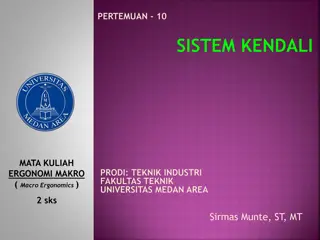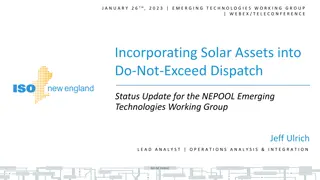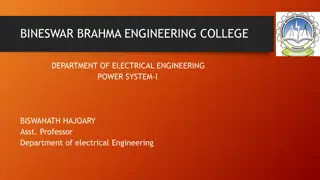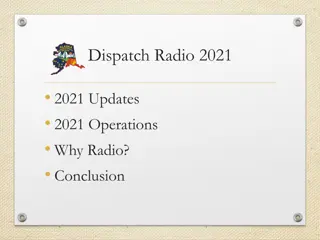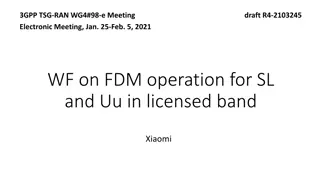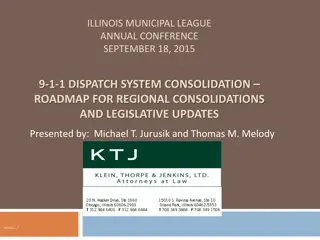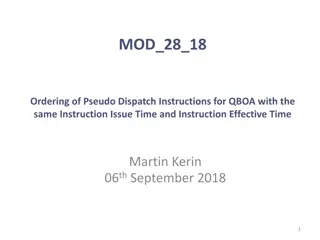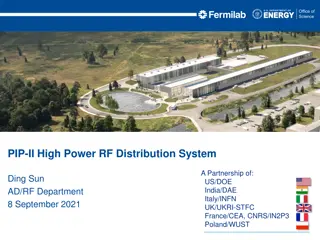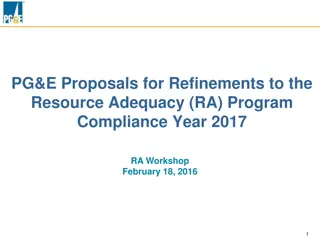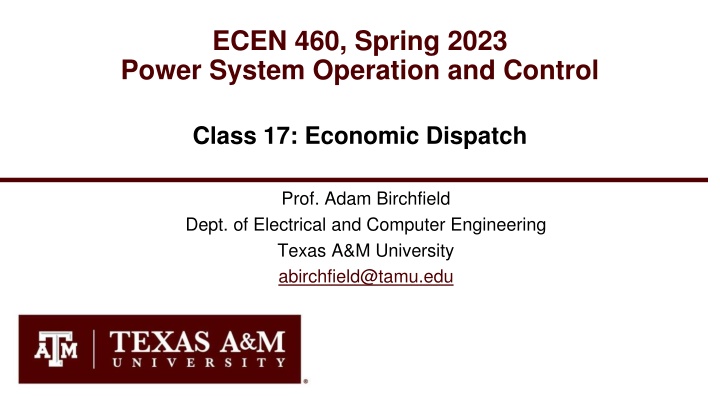
Power System Operation and Control - Economic Dispatch Overview
This content provides insights into the economic dispatch process in power system operation and control. It covers topics such as real-time ACE monitoring, AGC systems, manual ACE control scenarios, and multi-area operation considerations. The examples and illustrations enhance understanding of the concepts involved in maintaining balance and efficiency in power generation and distribution systems.
Download Presentation

Please find below an Image/Link to download the presentation.
The content on the website is provided AS IS for your information and personal use only. It may not be sold, licensed, or shared on other websites without obtaining consent from the author. If you encounter any issues during the download, it is possible that the publisher has removed the file from their server.
You are allowed to download the files provided on this website for personal or commercial use, subject to the condition that they are used lawfully. All files are the property of their respective owners.
The content on the website is provided AS IS for your information and personal use only. It may not be sold, licensed, or shared on other websites without obtaining consent from the author.
E N D
Presentation Transcript
ECEN 460, Spring 2023 Power System Operation and Control Class 17: Economic Dispatch Prof. Adam Birchfield Dept. of Electrical and Computer Engineering Texas A&M University abirchfield@tamu.edu
2 MISO Real-Time ACE Example MISO's real-time ACE is available online (along with lots of other data) https://www.misoenergy.org/MARKETSOPERATIONS/REALTIMEMARKETDATA/Pages/ACEChart.aspx
3 Multi-Area Operation Statement 20. Areas have an automatic generator control (AGC) system that sends signals to generators to change their MW outputs to help control the ACE and make sure load and generation balance with scheduled interchanges. Most utilities use automatic generation control (AGC) to automatically change their generation to keep their ACE close to zero Usually the utility control center calculates ACE based upon tie-line flows; then the AGC module sends control signals out to the generators every couple seconds.
4 Three Bus Case with Manual ACE Control Generation is manually changed to match change in load, keep ACE close to zero
5 Three Bus Case with AGC Ripple is due to the deadband, used to prevent excessive change in the generation Generation real power is now being automatically controlled
6 Multi-Area Operation Statement 21. Transactions within areas and between areas will not exclusively follow the direct paths and may sometimes create loop flows through non-participating areas.
7 Seven Bus Case: One-line 44 MW -42 MW -31 MW 31 MW 80 MW 30 MVR System has three areas 1.05 PU 0.99 PU 3 4 1 1.00 PU Area top has five buses 106 MW AGC ON 62 MW -37 MW 110 MW 40 MVR -32 MW 94 MW AGC ON Case Hourly Cost 16933 $/MWH 38 MW -14 MW -61 MW 32 MW 1.04 PU 1.01 PU 79 MW -77 MW Top Area Cost 8029 $/MWH 5 2 40 MW 20 MVR 130 MW 40 MVR -39 MW 40 MW 168 MW AGC ON 40 MW -40 MW 20 MW -20 MW 1.04 PU 1.04 PU 6 7 20 MW -20 MW 200 MW 0 MVR 200 MW 0 MVR Left Area Cost 4189 $/MWH Right Area Cost 4715 $/MWH 200 MW AGC ON 201 MW AGC ON Area left has one bus Area right has one bus
8 Seven Bus Case: Area View Area Losses 7.09 MW Top Actual flow between areas 40.1 MW -40.1 MW 0.0 MW 0.0 MW System has 40 MW of Loop Flow Scheduled flow Left Right Area Losses 0.33 MW Area Losses 0.65 MW 40.1 MW 0.0 MW Loop flow can result in higher losses
9 Seven Bus - Loop Flow? Area Losses 9.44 MW Top Note that Top s Losses have increased from 7.09MW to 9.44 MW 4.8 MW -4.8 MW 0.0 MW 0.0 MW Left Right Area Losses -0.00 MW Area Losses 4.34 MW 104.8 MW 100.0 MW Transaction has actually decreased the loop flow 100 MW Transaction between Left and Right
10 Generator Dispatch and Electricity Pricing Statement 22. The actual generator dispatch is by economics, but it is subject to constraints associated with transmission system, including contingency constraints. Area Name: Home ACE: -1.7 MW MW Load: 551.9 MW MW Gen: 555.1 MW Home Area -74.5 MW 16.4 Mvar 75.1 MW -13.5 Mvar Bus 2 Bus 1 MW Losses: 4.92 MW Dispatch is no longer optimal due to need to keep line from bus 2 to bus 3 from overloading A 1.000 pu A MVA 367.9 MW MVA 184.0 Mvar slack 1.000 pu A 101.7 MW 10.1 Mvar A 101% MVA MVA -143.4 MW 49.3 Mvar 150.0 MW AGC ON AVR ON -73.4 MW 23.6 Mvar A A 100.0 MW 101% MVA 249.7 Mvar MVA Other Area 146.8 MW -37.8 Mvar 74.3 MW -20.7 Mvar Scheduled Transactions Bus 3 1.000 pu 0.0 MW 184.0 MW 92.0 Mvar ED 405.1 33.5 Mvar MW AGC ON AVR ON
11 Security Constrained Economic Dispatch Transmission constraints often limit system economics. Such limits required a constrained dispatch in order to maintain system security. In three bus case the generation at bus 3 must be constrained to avoid overloading the line from bus 2 to bus 3.
12 Generator Dispatch and Electricity Pricing Statement 23. Electricity is priced locationally through locational marginal prices (LMPs). Cost to supply electricity to bus is called the locational marginal price (LMP) Presently some electric markets post LMPs on the web In an ideal electricity market with no transmission limitations the LMPs are equal Transmission constraints can segment a market, resulting in differing LMP Determination of LMPs requires the solution on an Optimal Power Flow (OPF)
13 Three Bus LMPs with Overload Ignored 60 MW 60 MW Bus 2 Bus 1 Gen 2 s cost is $12 per MWh 10.00 $/MWh Gen 1 s cost is $10 per MWh 0 MW 10.00 $/MWh 180 MW 120 MW 120% 0 MW MW 60 MW 120% 120 MW Total Cost 1800 $/hr 60 MW 10.00 $/MWh Bus 3 180 MW MW Line from Bus 1 to Bus 3 is over-loaded; all buses have same marginal cost 0 MW
14 Now with the Line Limit Enforced 20 MW 20 MW Bus 2 Bus 1 10.00 $/MWh 60 MW 12.00 $/MWh 120 MW 100 MW 100% 80% 0 MW MW 80 MW 100% 80% 100 MW Total Cost 1921 $/hr 80 MW 14.01 $/MWh Bus 3 180 MW MW Line from 1 to 3 is no longer overloaded, but now the marginal cost of electricity at 3 is $14 / MWh 0 MW
15 ERCOT LMPs 9/9/17 at 12:47 PM http://www.ercot.com/content/cdr/contours/rtmLmpHg.html
16 MISO LMPs 9/13/17 at 8:10 AM https://www.misoenergy.org/LMPContourMap/MISO_All.html
17 Generator Dispatch and Electricity Pricing Statement 24. Flowgates are constraints in the dispatch under base or contingency conditions, restricting the allowed flow through one or more parallel transmission paths. The real-time loading of the power grid is accessed via flowgates A flowgate flow is the real power flow on one or more transmission element for either base case conditions or a single contingency contingent flows are determined using LODFs Flowgates are used as proxies for other types of limits, such as voltage or stability limits Flowgates could be calculated using a spreadsheet A list of the MISO flowgates is given at http://www.oatioasis.com/woa/docs/MISO/MISOdocs/MISO- COORDINATED_FLOWGATES.pdf
18 Line Outage Distribution Factors (LODFS) LODFs are used to approximate the change in the flow on one line caused by the outage of a second line typically they are only used to determine the change in the MW flow LODFs are used extensively in real-time operations LODFs are state-independent but do dependent on the assumed network topology = P LODF P , l l k k
19 NERC Regional Reliability Councils NERC is the North American Electric Reliability Council Image: www.nerc.com/AboutNERC/keyplayers/PublishingImages/2017_NERC_Regions_May2017.jpg
20 Economic Dispatch Problem, Example 1 A system has two generators with the following cost curves. ?1 and ?2 are the generator costs, in $/hr ?1 and ?2 are the generator real power outputs, in MW ?1?1 = 5500 + 14 ?1+ 0.002 ?1 ?2?2 = 2000 + 12 ?2+ 0.004 ?2 Each generator must be dispatched within the following limits 10 MW ?1 200 MW 50 MW ?2 500 MW If the total system load is 325 MW, what should be ?1 and ?2 to minimize the total system cost ?1+ ?2? Also, what is the incremental cost to supply 1 more MW? How does the solution change if the load goes up to 400 MW? Down to 250 MW? Up to 570 MW? Up to 750 MW? 2 2
21 Economic Dispatch Problem, Example 1 Fundamental principle: For generators within their limits, the incremental cost should be equal to the system marginal cost ? So we basically have two equations: We need to meet the load ?1+ ?2= 325 And we need the incremental cost (derivatives) to be equal ? =??1 ??1 Take the derivatives to find the incremental cost ? =??1 ??1 ? =??2 ??2 =??2 ??2 = 14 + 0.004 ?1 = 12 + 0.008 ?2 $ Solving, we get ?1= 50 MW,?2= 275 MW,? = 14.2 ??
22 Economic Dispatch Problem, Example 1 Now try with the other values of the load For load of 400 MW, you get ?1= 100,?2= 300,? = 14.4 $/?? For load of 250 MW, you get ?1= 0,?2= 250,? = 14 $/?? For load of 570 MW, you get ?1= 213,?2= 357,? = 14.85 $/?? For load of 750 MW, you get ?1= 333,?2= 417,? = 15.33 $/?? But wait a minute, check the limits In the first case, we are fine, no limit violations In the second case, ?1 will be stuck at its min limit, ?1= 50, ?2= 200, ? = 13.6 $/?? In the third case, ?1 will be stuck at its max limit, ?1= 200, ?2= 370, ? = 14.96 $/?? In the fourth case, we have a problem!! Note that lambda and the incremental cost are related in this way ?? < ? ?? = ? ?? > ? ?? Generator at max limit ?? Generator not at limit ?? Generator at min limit
23 Homework For next class review DC power flow again Homework due 3/30/23: 6th edition: Problems 6.62, 6.63, 6.65 7th edition: Problems 7.1, 7.2, 7.4



